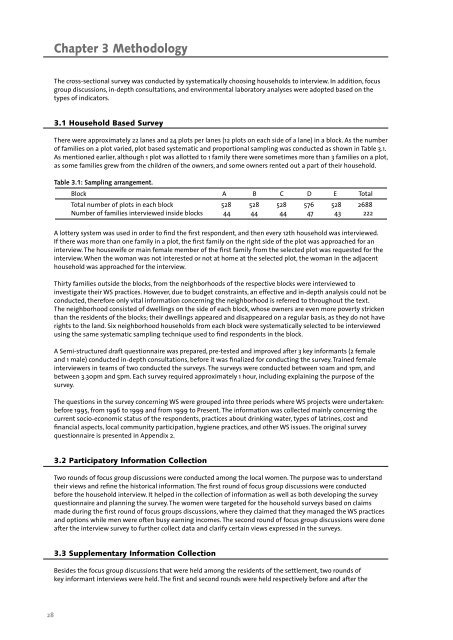Untitled - UNU-IAS - United Nations University
Untitled - UNU-IAS - United Nations University
Untitled - UNU-IAS - United Nations University
You also want an ePaper? Increase the reach of your titles
YUMPU automatically turns print PDFs into web optimized ePapers that Google loves.
Chapter 3 Methodology<br />
The cross-sectional survey was conducted by systematically choosing households to interview. In addition, focus<br />
group discussions, in-depth consultations, and environmental laboratory analyses were adopted based on the<br />
types of indicators.<br />
3.1 Household Based Survey<br />
There were approximately 22 lanes and 24 plots per lanes (12 plots on each side of a lane) in a block. As the number<br />
of families on a plot varied, plot based systematic and proportional sampling was conducted as shown in Table 3.1.<br />
As mentioned earlier, although 1 plot was allotted to 1 family there were sometimes more than 3 families on a plot,<br />
as some families grew from the children of the owners, and some owners rented out a part of their household.<br />
Table 3.1: Sampling arrangement.<br />
Block A B C D E Total<br />
Total number of plots in each block 528 528 528 576 528 2688<br />
Number of families interviewed inside blocks 44 44 44 47 43 222<br />
A lottery system was used in order to find the first respondent, and then every 12th household was interviewed.<br />
If there was more than one family in a plot, the first family on the right side of the plot was approached for an<br />
interview. The housewife or main female member of the first family from the selected plot was requested for the<br />
interview. When the woman was not interested or not at home at the selected plot, the woman in the adjacent<br />
household was approached for the interview.<br />
Thirty families outside the blocks, from the neighborhoods of the respective blocks were interviewed to<br />
investigate their WS practices. However, due to budget constraints, an effective and in-depth analysis could not be<br />
conducted, therefore only vital information concerning the neighborhood is referred to throughout the text.<br />
The neighborhood consisted of dwellings on the side of each block, whose owners are even more poverty stricken<br />
than the residents of the blocks; their dwellings appeared and disappeared on a regular basis, as they do not have<br />
rights to the land. Six neighborhood households from each block were systematically selected to be interviewed<br />
using the same systematic sampling technique used to find respondents in the block.<br />
A Semi-structured draft questionnaire was prepared, pre-tested and improved after 3 key informants (2 female<br />
and 1 male) conducted in-depth consultations, before it was finalized for conducting the survey. Trained female<br />
interviewers in teams of two conducted the surveys. The surveys were conducted between 10am and 1pm, and<br />
between 3.30pm and 5pm. Each survey required approximately 1 hour, including explaining the purpose of the<br />
survey.<br />
The questions in the survey concerning WS were grouped into three periods where WS projects were undertaken:<br />
before 1995, from 1996 to 1999 and from 1999 to Present. The information was collected mainly concerning the<br />
current socio-economic status of the respondents, practices about drinking water, types of latrines, cost and<br />
financial aspects, local community participation, hygiene practices, and other WS issues. The original survey<br />
questionnaire is presented in Appendix 2.<br />
3.2 Participatory Information Collection<br />
Two rounds of focus group discussions were conducted among the local women. The purpose was to understand<br />
their views and refine the historical information. The first round of focus group discussions were conducted<br />
before the household interview. It helped in the collection of information as well as both developing the survey<br />
questionnaire and planning the survey. The women were targeted for the household surveys based on claims<br />
made during the first round of focus groups discussions, where they claimed that they managed the WS practices<br />
and options while men were often busy earning incomes. The second round of focus group discussions were done<br />
after the interview survey to further collect data and clarify certain views expressed in the surveys.<br />
3.3 Supplementary Information Collection<br />
Besides the focus group discussions that were held among the residents of the settlement, two rounds of<br />
key informant interviews were held. The first and second rounds were held respectively before and after the<br />
28
















